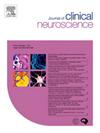Risk factors for residual dizziness after successful repositioning in elderly patients with benign paroxysmal positional vertigo
IF 1.9
4区 医学
Q3 CLINICAL NEUROLOGY
引用次数: 0
Abstract
Objective
This study aims to investigate the factors influencing RD in elderly patients with BPPV following successful manual reduction.
Methods
A total of 112 elderly patients diagnosed with benign paroxysmal positional vertigo (BPPV) were selected. The patients’ general information, comorbidities, and scores on the Dizziness Handicap Inventory (DHI) were recorded. Following a successful canalith repositioning procedure (CRP), bone mineral density (BMD) was assessed using dual-energy X-ray absorptiometry and evaluated with the T-score. The mean blood flow velocity (Vm) and pulse index (PI) of the bilateral middle cerebral arteries (MCA) and basilar artery (BA) were measured using transcranial Doppler (TCD). Cerebrovascular reactivity (CVR) was evaluated through the Breath Holding Index (BHI). White matter lesions are assessed using cranial Magnetic Resonance Imaging (MRI) and evaluated with the Leukoaraiosis score (LA-score). The patients were divided into residual dizziness (RD) and non-RD groups based on the presence of RD one week after the reduction. The effects of bone mineral density, cerebral blood flow, and cerebral white matter on short-term RD in elderly BPPV patients were subsequently evaluated.
Results
In the RD group, the DHI and LA-score were significantly higher than those in the non-RD group, while the T-score and BHI were lower, with statistically significant differences between the two groups (P < 0.05). The decreases in BHI and T-score, along with the increases in DHI and LA-score, were identified as risk factors for short-term RD following reduction in elderly patients with BPPV. Multivariate logistic regression analysis indicated that BHI, T-score, and LA-score were independent risk factors for RD. T-score and BHI exhibited a negative correlation with RD, while LA-score demonstrated a positive correlation. The diagnostic performance of each indicator was evaluated using ROC curve analysis. The results showed that the AUC for BHI was 0.715, T-score was 0.730, and LA-score was 0.732. Notably, when the three indicators were combined, the AUC significantly increased to 0.842, demonstrating high diagnostic efficiency, with a sensitivity of 70.73 % and a specificity of 90.14 %.
Conclusion
The decreases in the BHI and T-score, along with the increases in the DHI and LA-score, are all identified as risk factors for short-term RD following reduction in elderly patients with BPPV. BHI, T-score, and LA-score serve as independent risk factors for RD and can effectively predict its occurrence, with their combined predictive value being superior. BMD, CVR, and LA were utilized to predict short-term RD after successful manual reduction of BPPV.
求助全文
约1分钟内获得全文
求助全文
来源期刊

Journal of Clinical Neuroscience
医学-临床神经学
CiteScore
4.50
自引率
0.00%
发文量
402
审稿时长
40 days
期刊介绍:
This International journal, Journal of Clinical Neuroscience, publishes articles on clinical neurosurgery and neurology and the related neurosciences such as neuro-pathology, neuro-radiology, neuro-ophthalmology and neuro-physiology.
The journal has a broad International perspective, and emphasises the advances occurring in Asia, the Pacific Rim region, Europe and North America. The Journal acts as a focus for publication of major clinical and laboratory research, as well as publishing solicited manuscripts on specific subjects from experts, case reports and other information of interest to clinicians working in the clinical neurosciences.
 求助内容:
求助内容: 应助结果提醒方式:
应助结果提醒方式:


